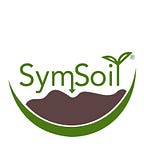Soil Microbe Biome
Plants have their own microbiome, just like people. Humans have microbes on their skin and inside their body. Probiotics are designed to add microbes that humans want to encourage within their digestive track. Plants have a similar system where microorganisms, including bacteria and fungi, live on and in plant roots. Rather than pro-biotics in the gut, the soil microbes could be called pre-biotics in the rhizosphere.
Originally described in the 1980’s by Elaine Ingham PhD, the academic literature describes the soil microbe biome as a Soil Food Web, the complex community which feeds and consumes each other.
It starts with the plants farming the microbes near their roots, the rhizosphere. The roots extrude sugars, proteins and carbohydrates which attract and feed bacteria, archaea and fungi.
This diagram is the classic representation of Dr. Ingham’s Soil Food Web from the USDA Website.
A handful of healthy soil has more individual life forms than there are humans living today.
Extrudates from the plant’s roots feed bacteria, archaea and fungi that live nearby. These may help the plant directly, with growth stimulants, bringing water from the periphery into the rhizosphere (area near the roots) or fixing nitrogen. Each of these life forms creates enzymes which include elements the plant needs, but the important elements (N-P-K and the minor ones) are bound in the enzymes and unavailable to plants.
These bacteria and fungi, are in turn, eaten by protozoa and beneficial nematodes. As these “wee critters” higher on the food chain consume the bacteria and fungi, their “waste” releases the nutrients that have been used by the bacteria and fungi, in plant available forms.
Since the 1800’s, humanity understood this in terms of chemistry. Now, in the 21st century, humanity has a greater understanding of and appreciation for the biological processes that created the enzymes, proteins, acids, carbohydrates, sugars and other natural chemicals found in healthy soil.
In addition to the microbes described above, there are other components to healthy soil. Worms, insect larvae, larger nematodes and insects (some of which are too small to see unaided) that travel through the soil, consuming smaller lifeforms, as well as each other, creating pockets for air and water, which allows all of the aerobic microbes to live.
In all, a healthy soil has over 10,000 species and at least 7 types of life: bacteria and archaea, the smallest single cellular lifeforms, fungi, protozoa of various types (amoebae, flagellates), nematodes (most of which are beneficial), and micro-arthropods. There are other life forms, but these seven are the keystone, or most critical ones, for soil health.
This is the second article, which begins with 21st Century Farmer’s Guide to Sustainable Farming, An Overview which can be found here. We encourage you to follow us for all the updates.
SymSoil’s blog also has 2 articles that comprehensively discuss the soil food web, Unsung Heros, The Soil Food Web and a more technical article that links to pages with more detail on each kingdom in the soil microbe biome, Soil Food Web — SymSoil’s Perspective.
More on the 21st Century Grower’s Guide to Sustainable Farming
Pt 3 Benefits of a Healthy Soil Microbe Biome
Part 4 Healthy Soil has 7 Types of Life
Part 5 The Right Microbe Biome Balance for Your Crop
Part 7 20th Century Farming vs Biological Farming
For more information, please visit our website SymSoil.com or https://symsoil.com/soil-food-web-soil-cities/
SymSoil Inc. is an evidence-based, soil health company with products and services for regenerative agriculture. Our flagship products are Robust Compost, Fungal Infused Biochar and Grow Cubes for the cannabis and hemp cultivators. Our science team has 35 years of experience developing solutions to growers’ problems based upon a deep understanding of the complete soil microbe biome. A core belief is regional soil microbes can be restored to regenerate the soil, which will significantly increase plant health, crop yields, flavor profile and nutrient density, as the plants access nutrients the way nature intended.
